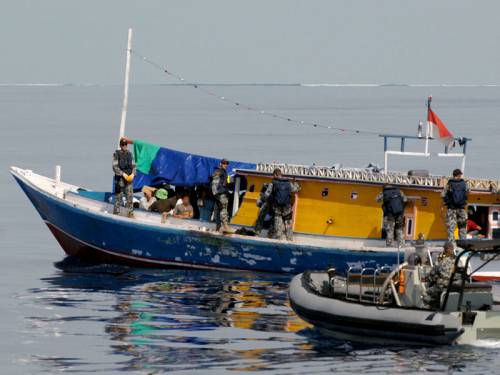
Australian lower house has approved laws allowing offshore processing camps for asylum seekers to be re-established in Papua New Guinea and Nauru.
The MPs passed a bill presented to parliament on Tuesday, following recommendations from an expert panel.
The bill now goes to the Senate, where it is expected to pass in coming days because both the governing Labor Party and the opposition back it.
Labor, under former Prime Minister Kevin Rudd, closed the camps in 2008.
The debate on the legislation in the lower house lasted for six hours on Tuesday and continued the next day. Only two MPs – an independent and one from the Australian Greens party – voted against the bill.
Immigration Minister Chris Bowen, speaking before the vote, said it was important that the bill pass.
“The Australian people expect no less and the people smugglers fear nothing more,” he said.
Prime Minister Julia Gillard – whose party had until Monday opposed the move – said on Tuesday that she hoped processing centres for asylum seekers could be reopened “within a month”.
The vote followed the release on Monday of a report by an expert panel appointed by Julia Gillard to break the deadlock on the issue of asylum.
It set out 22 recommendations aimed at tackling people-smuggling issues, including re-opening mothballed offshore processing centres.

The move comes amid rising numbers of asylum seekers travelling to Australia by boat from Indonesia.
Officials reported that at least three boats carrying more than 150 people were intercepted on Tuesday.
Australian officials say offshore processing is needed as a deterrent against making the perilous journey – pointing out that many lives have been lost in sinkings in recent years.
But critics say the policy – known as the Pacific Solution before it was scrapped in 2008 – violates asylum seekers’ rights.
In the past detainees on Nauru mounted multiple hunger strikes to protest against both conditions and the length of their detention.
Small protests against offshore processing have been reported outside immigration offices in Sydney and Melbourne.
Melissa Park, a Labor MP, earlier said that the measures being debated were “at the lower end of what we are capable of as a nation”.
“There are strong concerns about the devastating consequences, including severe mental health issues of detention of asylum seekers for indeterminate periods on Nauru and Manus Island,” she said.
The Pacific Solution was introduced in 2001 by the government of John Howard, in response to a reported rise in the number of asylum seekers arriving by boat.
Processing centres were set up on Nauru and on Manus Island in Papua New Guinea, the governments of the two nations receiving millions of dollars in aid in exchange.
The Australian navy diverted all boats carrying asylum seekers to those camps, where many were detained for months – sometimes years – under high security.
Many Australians did support the policy but rights groups condemned it and accused Australia of failing to meet its obligations under refugee conventions.
Australia asylum:
• In 2010, there were 6,535 Irregular Maritime Arrivals (IMAs – people coming by sea) in 134 vessels
• In 2011, 4,565 IMAs arrived in 69 vessels
• As of 13 August 2012, 7,629 IMAs had arrived in 114 boats
• To date, July has been the busiest month, with 1,798 IMAs
• Most of the IMAs from 2009-2011 came from Afghanistan, Sri Lanka and Iran
• Some asylum-seekers arrive by plane. Between July 2010 and June 2011, 6,316 people applied in this way
Source: Australian Department of Immigration and Citizenship
Pacific Solution
• Established in 2001 under conservative government of John Howard
• Asylum seekers arriving by boat detained in offshore centres in PNG and Nauru
• Rights groups criticized the conditions in which people were held, as detainees went on repeated hunger strikes
• Labor’s Kevin Rudd elected in November 2007, said Pacific Solution would end
• Last detainees left Nauru in February 2008